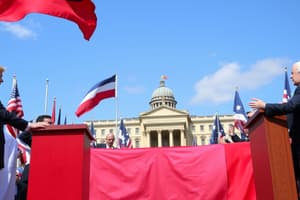Podcast
Questions and Answers
What are the roles of the party-in-the-electorate, the party as an organization, and the party-in-government?
What are the roles of the party-in-the-electorate, the party as an organization, and the party-in-government?
The party-in-the-electorate consists of individuals who see themselves as party members; the party as an organization has a national office and seeks electoral victory; the party-in-government includes elected officials who identify with the party.
Which of the following are ways political parties serve as key linkage institutions? (Select all that apply)
Which of the following are ways political parties serve as key linkage institutions? (Select all that apply)
- They pick policymakers (correct)
- They solely run campaigns
- They give cues to voters (correct)
- They coordinate policy-making (correct)
What is Anthony Downs' rational-choice theory?
What is Anthony Downs' rational-choice theory?
It suggests that political parties and actors prioritize goals like winning elections over ideology, leading them to adopt broadly appealing policies.
The historical development of the American two-party system includes the period of ______: 1796-1824.
The historical development of the American two-party system includes the period of ______: 1796-1824.
What is meant by party eras in American history?
What is meant by party eras in American history?
What is party dealignment?
What is party dealignment?
Which of the following characterizes the Democratic Party's ideology?
Which of the following characterizes the Democratic Party's ideology?
Which characteristic is associated with the Republican Party's ideology?
Which characteristic is associated with the Republican Party's ideology?
Flashcards are hidden until you start studying
Study Notes
Roles of Political Parties
- Party-in-the-Electorate: Individuals identifying with a party without formal membership; influences voting behavior.
- Party as an Organization: Structured with offices, staff, and resources at national, state, and local levels; focused on electoral success.
- Party-in-Government: Elected officials affiliated with a party; main spokespersons even if they disagree on specific policies.
Functions of Political Parties
- Nomination: Parties endorse candidates for elections, playing a crucial role in selecting policymakers.
- Campaign Management: Parties organize and support campaigns, though candidates increasingly campaign independently due to technology.
- Voter Cues: Despite weakened party ties, they still provide voters with recognizable cues for decision-making.
- Policy Articulation: Each party promotes specific policy alternatives both for the electorate and within government.
- Policy Coordination: Party members collaborate on policy; office holders often seek support from fellow party members.
Anthony Downs' Rational-Choice Theory
- Rational-choice theory posits that parties prioritize winning elections over strict ideological adherence.
- Parties and voters aim to maximize their goals through rational decision-making in choosing policies.
- Successful parties focus on issues with broad appeal, aligning closely with the moderate views of the electorate.
- Both major parties, Democrats and Republicans, maintain distinct identities to build voter loyalty, despite appearing similar at times.
Historical Development of the American Two-Party System
- 1796-1824: Competition between Federalists and Democratic-Republicans.
- 1828-1856: Rise of Jacksonian Democrats against Whigs.
- 1860-1928: Dominance of the Republican Party.
- 1932-1964: Era of the New Deal Coalition led by Democrats.
- 1968-Present: Ongoing trend of divided government.
Party Eras, Critical Elections, and Realignment
- Party Eras: Periods dominated by one party, interrupted by critical elections that reshape coalitions.
- Critical Elections: Major events that introduce significant new issues leading to changes in electoral alliances.
- Party Realignment: Rare and often crisis-driven shifts in party support; examples include the Civil War and the Great Depression.
- Coalition Formation: Each party creates lasting coalitions of varied groups; shifts can take multiple elections to manifest.
Significance of Divided Government
- Since 1968, a prolonged era of divided government has emerged, with different parties controlling the executive and legislative branches.
- Party Dealignment: Growing numbers of citizens identify as independents, moving away from strong party affiliation.
- Scholars suggest divided government may reflect a failure of parties to serve effectively, indicating a trend toward dealignment rather than realignment.
Ideology of Democratic and Republican Parties
- Democrats: Tend to be liberal, advocating for a strong national government and increased public services, supported by higher taxes and spending.
- Republicans: Generally conservative, favoring limited government, lower taxes, and fiscal responsibility without defined details in this section.
Studying That Suits You
Use AI to generate personalized quizzes and flashcards to suit your learning preferences.





